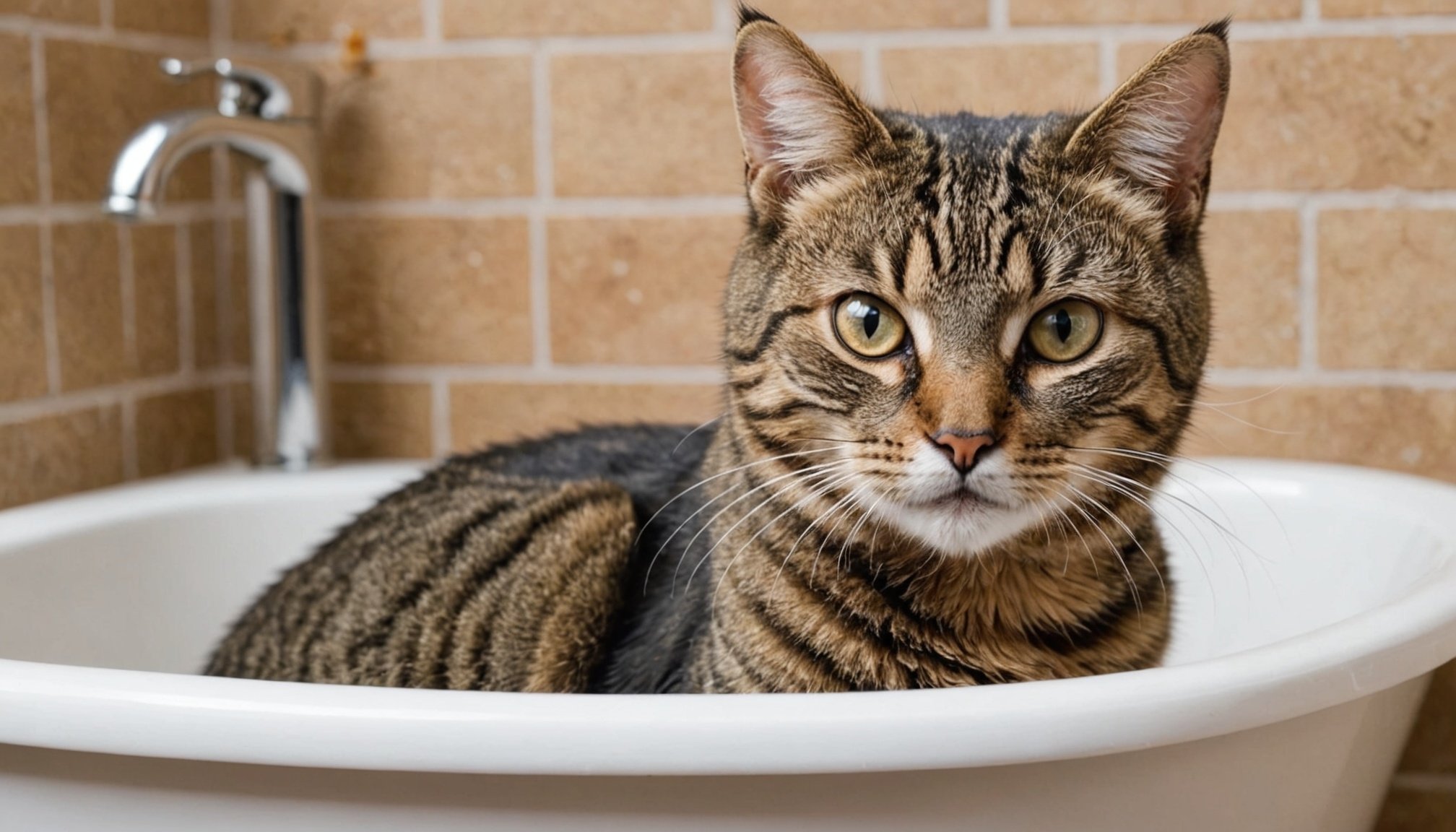Understanding Water-Resistant Cats
Cats with water-resistant fur possess unique characteristics that require special attention when it comes to bathing. These feline breeds, such as the Turkish Van and Maine Coon, have a dense, water-repellent coat. Their fur enables them to stay relatively dry, even when exposed to water. Understanding these characteristics is crucial for appropriate feline hygiene techniques and ensuring their well-being.
While the water-resistant nature of their fur provides some protection, it also poses unique challenges during bathing. Their dense fur can trap oils and debris, necessitating a proper hygiene routine. Implementing effective bathing practices is vital to maintain their coat’s health and ensure any dirt or allergens are thoroughly removed.
The approach to bathing these cats varies to accommodate their specific needs. Traditional bathing methods may not suffice, as these breeds require techniques that respect their unique bathing needs. Grooming should be gentle, with particular care taken to avoid tangling or stressing their fur. Additionally, the products used should cater to the sensitive skin beneath their robust coats.
Addressing these factors is essential to navigate the bathing process effectively, making hygiene maintenance for water-resistant cats a manageable task.
In the same genre : Spotting Early Diabetes Signs in Your Feline Friend: The Ultimate Guide for Cat Owners
Bathing Preparation
When it comes to bathing preparation for water-resistant cats, choosing the appropriate location is paramount. A calm, quiet environment will help minimize stress. Bathrooms with a non-slip surface or using a dedicated basin can provide a controlled space.
Before the bath begins, gather necessary cat grooming essentials. These may include cat-specific shampoo, a gentle brush, and towels. Ensuring all equipment is within reach reduces interruptions, making the process smoother for both you and the cat. For particularly anxious cats, considering calming sprays or pheromone diffusers might ease pre-bath jitters.
Engaging in a pre-bath routine can help acclimate your cat to the upcoming experience. Gentle brushing removes loose fur and prevents tangles, making shampooing easier. Letting your cat explore the space, perhaps with treats or toys, can create positive associations with bath time. Placing a non-slip mat in the basin or sink provides stability, preventing your cat from sliding, thereby easing some anxiety.
These preparatory steps create a stress-free experience, setting the stage for successful bathing. Adapting them to suit your cat’s individual preferences can lead to a more enjoyable routine for both parties.
Effective Bathing Techniques
When it comes to bathing water-resistant cats, employing specialised cat bathing methods is crucial for a smooth experience. Understanding these cats’ needs can make the process more pleasant for both you and your feline friend.
Step-by-Step Bathing Process
Start with a gradual introduction to water. Use lukewarm water to avoid discomfort, slowly wetting their coat to get them accustomed. Focus on soothing actions and speak in a calm, reassuring tone to foster a stress-free bathing atmosphere. Apply a cat-safe shampoo, specifically formulated for water-resistant fur, working it gently through the coat. Ensure thorough rinsing to prevent residue build-up, which could cause skin irritation.
Drying Techniques
Efficient drying follows bathing. Pat the fur with an absorbent towel rather than rubbing, which could cause tangling or damage. In winter, or in cold conditions, ensure your cat is fully dry to avoid chilling. Many cats prefer warm, quiet places to dry off.
Using the Right Water Temperature
Correct water temperature plays a significant role. Warm, but not hot, water ensures comfort, while a gentle flow reduces stress. Proper water temperature awareness promotes a positive bathing experience for your cat, preserving their trust in future hygiene sessions.
Recommended Products
Outfitting yourself with the right cat grooming products can simplify the bathing process for water-resistant cats. Choosing best shampoos designed specifically for these breeds is crucial. Look for a mild formula that accommodates the unique bathing needs of water-resistant cats while targeting oil and dirt removal effectively. This ensures that the natural protective oils of the coat remain intact, promoting both hygiene and health.
For grooming, cat-friendly brushes are indispensable. These brushes aid in removing loose hairs and unknots gently, preventing tangles even in dense fur. Opt for brushes with flexible bristles designed for sensitive skin to reduce shedding and maintain the coat’s luster.
- Gentle Brushes: Aid in detangling without pulling or causing discomfort.
Efficient product selection aligns with feline skin sensitivities, minimizing potential allergic reactions or irritations. Prioritize hypoallergenic or unscented options when considering shampoos and conditioners. Using the appropriate tools and products makes grooming less of a chore, fostering a harmonious experience.
With these grooming essentials, you can confidently care for your feline’s hygiene, making sure their water-resistant coats stay in optimal condition while supporting their overall health and comfort.
Addressing Common Challenges
Bathing water-resistant cats can present unique challenges, primarily due to their dense fur and individual temperaments. One common issue is anxiety or aggression during the bath. It’s crucial to adopt strategies that ease these behaviours to ensure an effective grooming session.
Understanding your cat’s body language is key. If your cat demonstrates signs of stress, like tail flicking or growling, pause and provide soothing reassurances. To alleviate stress, create a calming environment using soft music or pheromone diffusers to help your cat relax. Additionally, offering treats prior to bath time can establish a positive association.
It’s important to maintain a gentle demeanor and speak softly to reassure them. Should aggression occur, ensure you’re in a safe position and give the cat space to calm down. Use distraction techniques like toys or treats to gradually increase their comfort with water.
For persistent challenges, consider enlisting the help of a professional groomer, who can provide insights and tips specific to your cat’s needs. Implementing these stress management techniques can transform bath time from a battle into a more congenial experience.
Maintaining Overall Feline Hygiene
Ensuring effective cat hygiene routines extends beyond bath time and includes holistic care practices. Water-resistant breeds often require frequent grooming sessions to maintain their coat’s health and address any potential skin issues. Regular brushing aids in removing loose hairs and preventing matting, which is crucial for these cats’ dense fur.
For comprehensive health maintenance tips, watch for any unusual signs such as excessive scratching, lesions, or changes in coat texture. These could indicate underlying skin conditions that require attention. Early detection of skin issues can prevent more serious health problems.
Incorporating a balanced grooming schedule is vital. Aim to establish a routine that includes dental care and nail trimming. Brushing your cat’s teeth regularly with feline-approved toothpaste can prevent dental issues. Nail trimming should be done with care, ensuring you do not cut into the quick.
Providing these comprehensive care components not only supports hygiene but also promotes overall health and wellbeing. Building familiarity with your cat’s needs allows you to adapt your grooming approach, ensuring effective care tailored to their unique characteristics while fostering a stress-free environment.
Expert Insights and FAQs
Understanding the unique needs of water-resistant cats often prompts common queries. One such question is, “How often should these breeds be bathed?” Experts recommend bathing every 4-6 weeks, as their dense fur requires time to naturally expel dirt and oils. This routine respects these cats’ unique bathing needs and maintains optimal fur health.
A frequent concern revolves around dried mats in the fur. Are they avoidable? Yes, regular grooming is essential. Utilize cat-friendly brushes that suit the coat’s thickness, preventing tangles before they form. Daily brushing sessions can keep mats at bay, enhancing overall feline hygiene techniques.
Selecting cat grooming essentials becomes crucial when dealing with delicate skin. What products are best suited? Always opt for hypoallergenic shampoos and conditioners specifically crafted for water-resistant cats. This ensures sensitive skin remains unharmed while maintaining the coat’s integrity.
Lastly, how do you encourage a cat to enjoy bath time? Integrate positive reinforcement and calming methods into routines. Offer treats post-bath, and create a serene bathing environment with soft music and pheromone diffusers. Patience is key to fostering a cooperative and relaxed grooming experience.

